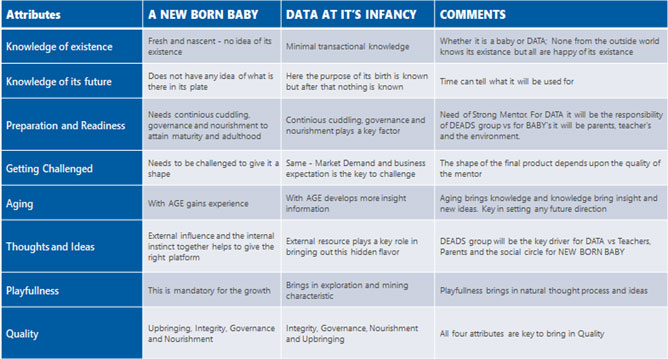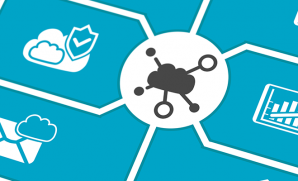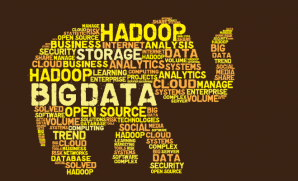DATA – On its own does not carry any importance. For it to gain any meaning and significance, an understanding of its source is essential. This is the same situation with a Newborn baby; Unless one does not know the parent and its ancestral tree, the mere existence is a challenge for the life of the baby.
To give it a shape, let it be an Infant or a Newly born data; one needs to have the background of the sourceto kick start the journey, which eventually goes through the rough path of transformation to face the challenge of future needs. This is when like a Parent for the Newborn baby, the DEADS (Data Engineers And Data Scientists) play a key role in giving DATA a form.
For any DEADS group, new data bears a lot of similarities to a newborn baby. Like any parent, I too have spent a ridiculous number of hours scratching my head over the behavioral patterns of my child, trying to understand the kind of training this new child would need, just like a DEADS would with a new data set.
Why is it so? Well, let’s see.
Like a BABY once born, the journey of life starts from day one. Similarly, once a DATA is born, its journey towards the life of exploration and insights starts. What a coincidence with real-life; Right at BIRTH, we had to use the DEADS expertise to nourish, govern, and expose (whether it is an INFANT BABY or INFANT DATA).
If you are from the DEADS team, you may (like me) will start scratching your brain to start trying to understand the data like how a parent tries to start understanding its baby, which starts from its first cry, demand for food, nutritional needs, interest, dislikes….etc. This attribute will train the parents to gain a better understanding and build the parenting capabilities for building the future of their baby.
DATA once taken birth, its journey towards radiation of information kicks off. Akin to a newborn baby, DEADS teams use their expertise to , nourish, and govern the ‘infant data.’ Once baby is given birth, hormonal control systems and brain synapses begin to organize permanently as per human interactions one experiences. Unnecessary brain receptors, as well as neural pathways, are disposed of, while those apt to the given environment, are enhanced. In the context of data, the demand remains the same since, by itself, the data has no meaning. With context, the corresponding data holds a functional purpose in the system, i.e., and it starts taking shape like brain synapses; unnecessary noise within the data is eliminated, and only the business purpose is served.
Now let us kick start and understand the different commonalities in this journey:
#1 – A mother’s vs. software interfacing application:
Mother’s care is the starting point of an infant’s life journey. She defines the purpose of life for a baby, and it requires a lot of interfacing to understand if her baby is hungry, uncomfortable, lonely, etc.
Similarly, any application that gives birth new data needs to embed all the metadata, define the purpose, create a continuous relationship between data points, address redundancy, etc.
#2 – A father vs. application user’s role:
A father’s role in an infant’s life is almost similar to how an application’s users understand and treat the data. The early father-child interactions create a lasting emotional bonding, helps the father better understand the child, and motivates him to change his care as the demands change.
Similarly, when business users start using an application, their understanding of the data and its structure matures slowly. It’s only over time and continuous attention that users get an insight of what is happening underneath the system which automatically facilitates the business community to think beyond what the system can do. This, in turn, changes their perspective towards requirements and enables the system to get enhanced.
#3 – Parenting vs. DEADS
Beyond individual roles, there is a critical cumulative role that parents play in an infant’s maturity journey. The aspect of the role is very interesting as itinvolves a healthy partnership between the father and mother so that that the kid gets adequate nourishing, upkeep, learning, values, and shaping to be a good and valuable citizen. Similarly, the business and DEADS group bring in the same perspective to the data and together play the parenting role to give a final product called analytics (Good Citizen).
In terms of maturity, let’s look at the multiple ways how a baby reaching adulthood compares with data being useful at Predictive & Prescriptive Analytics.
Maturity is achieved when:
- A person or data reaches adulthood by experience or,
- It gets the knowledge in a pattern that will derive meaningful and noticeable personality in a shorter time, and thereby provide future vision and path to the requestors
To put it in the perspective of raising a child, training from parents and teachers for knowledge and experience puts the child in the path towards maturity and leadership. Similarly, a new data, too, needs assistance from the DEADS team to be processed and taught for predictive and prescriptive analytics.
The table below should give you a fair idea of the similarities between DATA at its infancy and a Newborn child – and how each needs to be treated.

To know how YASH can help you make sense of your business data for profitable outcomes, please visit https://www.yash.com/digital-transformation/ for additional information, or contact us at https://www.yash.com/about-us/contact-us/.


















